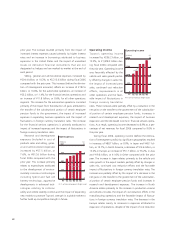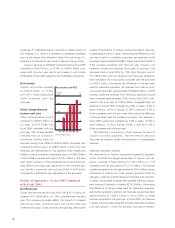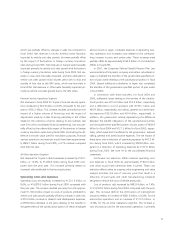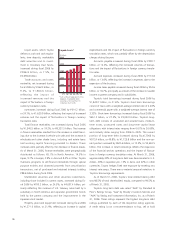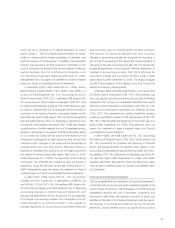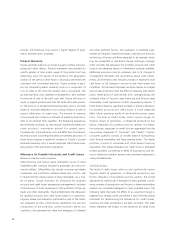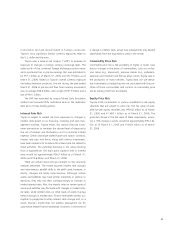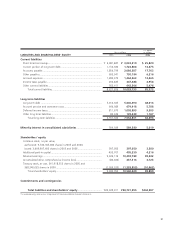Toyota 2006 Annual Report Download - page 79
Download and view the complete annual report
Please find page 79 of the 2006 Toyota annual report below. You can navigate through the pages in the report by either clicking on the pages listed below, or by using the keyword search tool below to find specific information within the annual report.
77
securities. A credit rating may be
subject to withdrawal or revision
at any time. Each rating should
be evaluated separately of any
other rating.
Toyota’s treasury policy is to
maintain controls on all expo-
sures, to adhere to stringent
counterparty credit standards,
and to actively monitor market-
place exposures. Toyota central-
ized, and is pursuing global
efficiency of, its financial services
operations through Toyota
Financial Services Corporation.
The key element of Toyota’s financial policy is maintaining a
strong financial position that will allow Toyota to fund its
research and development initiatives, capital expenditures and
financing operations on a cost effective basis even if earnings
experience short-term fluctuations. Toyota believes that it main-
tains sufficient liquidity for its present requirements and that by
maintaining its high credit ratings, it will continue to be able to
access funds from external sources in large amounts and at rela-
tively low costs. Toyota’s ability to maintain its high credit rat-
ings is subject to a number of factors, some of which are not
within Toyota’s control. These factors include general economic
conditions in Japan and the other major markets in which
Toyota does business, as well as Toyota’s successful implemen-
tation of its business strategy.
Toyota’s unfunded pension liabilities decreased during fiscal
2006 by ¥209.3 billion, or 40.6% to ¥306.7 billion. The
unfunded pension liabilities relate primarily to the parent com-
pany and its Japanese subsidiaries. The unfunded amounts will
be funded through future cash contributions by Toyota or in
some cases will be funded on the retirement date of each cov-
ered employee. The unfunded pension liabilities decreased in
fiscal 2006 compared to the prior year mainly due to the
increase in the market value of assets of the plans. See note 19
to the consolidated financial statements.
Off-Balance Sheet Arrangements
Securitization Funding
Toyota uses its securitization program as part of its funding for
its financial services operations. Toyota believes that the securiti-
zations are an important element of its financial services opera-
tions as it provides a cost-effective funding source.
Securitization of receivables allows Toyota to access a highly
liquid and efficient capital market while providing Toyota with
an alternative source of funding and investor diversification. See
note 7 to the consolidated financial statements with respect to
the impact on the balance sheet, income statement, and cash
flows of these securitizations.
Toyota’s securitization program involves a two-step transac-
tion. Toyota sells discrete pools of retail finance receivables to a
wholly-owned, bankruptcy remote special purpose entity
(“SPE”), which in turn transfers the receivables to a qualified
special purpose entity (“QSPE” or “securitization trust”) in
exchange for the proceeds from securities issued by the securiti-
zation trust. Once the receivables are transferred to the QSPE,
the receivables are no longer assets of Toyota and, therefore, no
longer appear in Toyota’s consolidated balance sheet. These
securities are secured by collections on the sold receivables and
structured into senior and subordinated classes.
The following flow chart diagrams a typical securitization
transaction:
Toyota’s use of SPEs in securitizations is consistent with
conventional practices in the securitization markets. The sale to
the SPE isolates the sold receivables from other creditors of
Toyota for the benefit of securitization investors and, assuming
accounting requirements are satisfied, the sold receivables are
accounted for as a sale. While Toyota retains subordinated
Off-balance
sheet
transaction
Toyota SPE
(Wholly-owned
by Toyota)
Investors
QSPE
(Securitization
Trust)
Receivables Receivables Securities
Proceeds
Proceeds Proceeds
Bankruptcy
remote
transaction
6,000
3,000
9,000
12,000
’02 ’03 ’04 ’05 ’06
0
40
20
60
80
0
Shareholders’ Equity
and Equity Ratio
(¥ Billion) (%)
Equity ratio (Right scale)
FY



